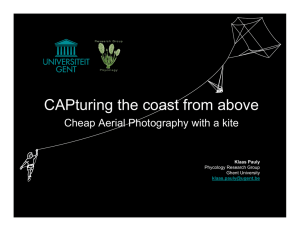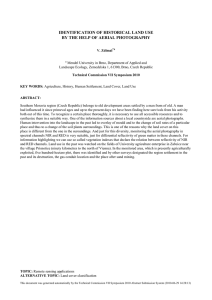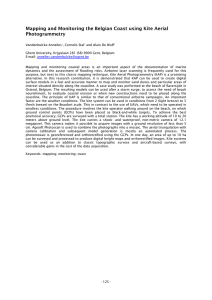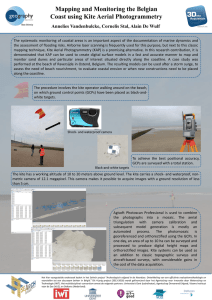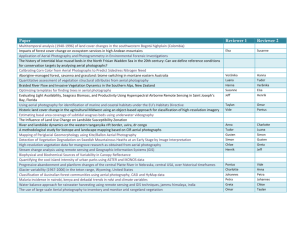UNMANNED SMALL-FORMAT AERIAL PHOTOGRAPHY FROM KITES FOR ACQUIRING LARGE-SCALE, HIGH-RESOLUTION, MULTIVIEW-ANGLE IMAGERY
advertisement
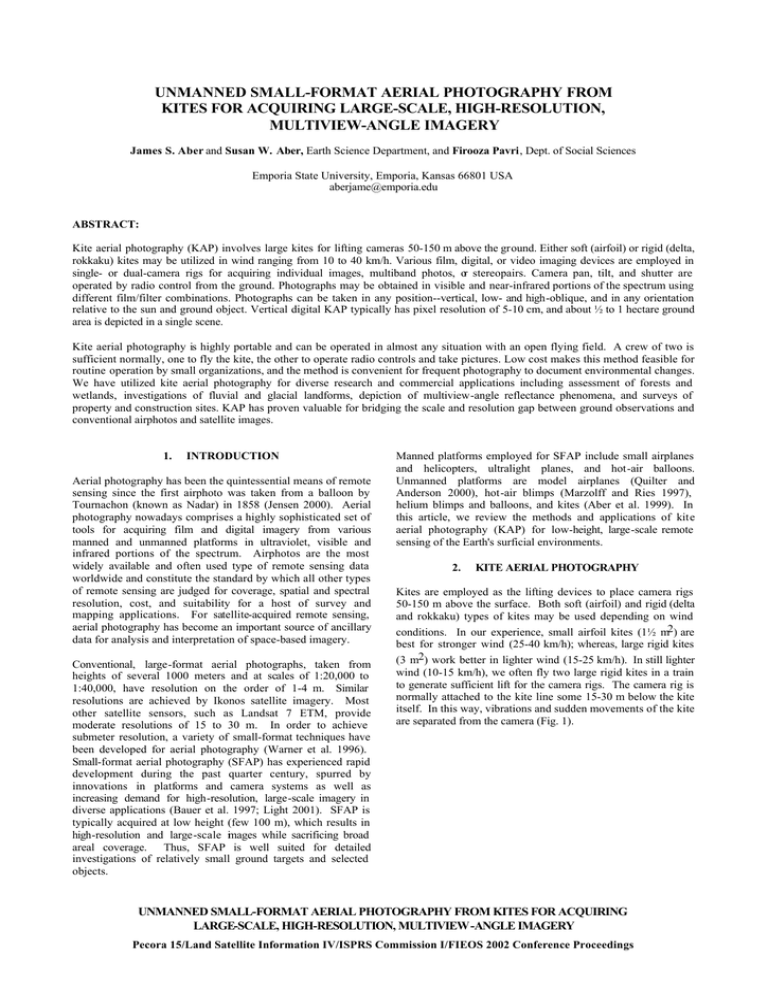
UNMANNED SMALL-FORMAT AERIAL PHOTOGRAPHY FROM KITES FOR ACQUIRING LARGE-SCALE, HIGH-RESOLUTION, MULTIVIEW-ANGLE IMAGERY James S. Aber and Susan W. Aber, Earth Science Department, and Firooza Pavri, Dept. of Social Sciences Emporia State University, Emporia, Kansas 66801 USA aberjame@emporia.edu ABSTRACT: Kite aerial photography (KAP) involves large kites for lifting cameras 50-150 m above the ground. Either soft (airfoil) or rigid (delta, rokkaku) kites may be utilized in wind ranging from 10 to 40 km/h. Various film, digital, or video imaging devices are employed in single- or dual-camera rigs for acquiring individual images, multiband photos, or stereopairs. Camera pan, tilt, and shutter are operated by radio control from the ground. Photographs may be obtained in visible and near-infrared portions of the spectrum using different film/filter combinations. Photographs can be taken in any position--vertical, low- and high-oblique, and in any orientation relative to the sun and ground object. Vertical digital KAP typically has pixel resolution of 5-10 cm, and about ½ to 1 hectare ground area is depicted in a single scene. Kite aerial photography is highly portable and can be operated in almost any situation with an open flying field. A crew of two is sufficient normally, one to fly the kite, the other to operate radio controls and take pictures. Low cost makes this method feasible for routine operation by small organizations, and the method is convenient for frequent photography to document environmental changes. We have utilized kite aerial photography for diverse research and commercial applications including assessment of forests and wetlands, investigations of fluvial and glacial landforms, depiction of multiview-angle reflectance phenomena, and surveys of property and construction sites. KAP has proven valuable for bridging the scale and resolution gap between ground observations and conventional airphotos and satellite images. 1. INTRODUCTION Aerial photography has been the quintessential means of remote sensing since the first airphoto was taken from a balloon by Tournachon (known as Nadar) in 1858 (Jensen 2000). Aerial photography nowadays comprises a highly sophisticated set of tools for acquiring film and digital imagery from various manned and unmanned platforms in ultraviolet, visible and infrared portions of the spectrum. Airphotos are the most widely available and often used type of remote sensing data worldwide and constitute the standard by which all other types of remote sensing are judged for coverage, spatial and spectral resolution, cost, and suitability for a host of survey and mapping applications. For satellite-acquired remote sensing, aerial photography has become an important source of ancillary data for analysis and interpretation of space-based imagery. Conventional, large-format aerial photographs, taken from heights of several 1000 meters and at scales of 1:20,000 to 1:40,000, have resolution on the order of 1-4 m. Similar resolutions are achieved by Ikonos satellite imagery. Most other satellite sensors, such as Landsat 7 ETM, provide moderate resolutions of 15 to 30 m. In order to achieve submeter resolution, a variety of small-format techniques have been developed for aerial photography (Warner et al. 1996). Small-format aerial photography (SFAP) has experienced rapid development during the past quarter century, spurred by innovations in platforms and camera systems as well as increasing demand for high-resolution, large-scale imagery in diverse applications (Bauer et al. 1997; Light 2001). SFAP is typically acquired at low height (few 100 m), which results in high-resolution and large-scale images while sacrificing broad areal coverage. Thus, SFAP is well suited for detailed investigations of relatively small ground targets and selected objects. Manned platforms employed for SFAP include small airplanes and helicopters, ultralight planes, and hot-air balloons. Unmanned platforms are model airplanes (Quilter and Anderson 2000), hot-air blimps (Marzolff and Ries 1997), helium blimps and balloons, and kites (Aber et al. 1999). In this article, we review the methods and applications of kite aerial photography (KAP) for low-height, large-scale remote sensing of the Earth's surficial environments. 2. KITE AERIAL PHOTOGRAPHY Kites are employed as the lifting devices to place camera rigs 50-150 m above the surface. Both soft (airfoil) and rigid (delta and rokkaku) types of kites may be used depending on wind conditions. In our experience, small airfoil kites (1½ m2) are best for stronger wind (25-40 km/h); whereas, large rigid kites (3 m2) work better in lighter wind (15-25 km/h). In still lighter wind (10-15 km/h), we often fly two large rigid kites in a train to generate sufficient lift for the camera rigs. The camera rig is normally attached to the kite line some 15-30 m below the kite itself. In this way, vibrations and sudden movements of the kite are separated from the camera (Fig. 1). UNMANNED SMALL-FORMAT AERIAL PHOTOGRAPHY FROM KITES FOR ACQUIRING LARGE-SCALE, HIGH-RESOLUTION, MULTIVIEW-ANGLE IMAGERY Pecora 15/Land Satellite Information IV/ISPRS Commission I/FIEOS 2002 Conference Proceedings kite flyer. They may communicate via small personal radios. KAP may be completely mobile, so location of the camera may be shifted easily in relation to the ground target and sun position. Combined with the pan and tilt functions of the camera rigs, this allows for airphotos to be acquired in all possible orientations relative to the ground scene. Figure 1. Cartoon showing setup for kite aerial photography (KAP). A radio transmitter on the ground controls operation of the camera rig. Illustration not to scale. We normally use three types of single-camera rigs for most photographic purposes. Each rig has full control of camera position (pan and tilt) via radio transmitter from the ground. The camera shutter also is triggered by radio command. The three single-camera rigs are described briefly. • Olympus Stylus Epic -- 35-mm film, point-and-shoot camera with automatic light settings and fixed 35-mm lens. Designed for extreme lightness, this rig weighs only 20 oz (570 g). Normal-color slide film is utilized routinely for general "snapshot" views. • Canon EOS RebelX -- a 35-mm, full-featured, SLR camera with zoom lens. This heavier rig, 36 oz (~1 kg), is used for special applications, namely color-infrared film photography. A yellow filter is added, and light settings are adjusted manually based on prior experience (Aber et al. 2001). • Canon PowerShot 100/110 Digital Elph -- 1200 x 1600 pixel CCD with automatic light settings and 40-mm equivalent lens. With a large memory card, more than 100 high-resolution images can be saved, and the images can be reviewed immediately after each flight. Weight of this rig is 22 oz (625 g). Aerial photography is undergoing a steady shift from analog to digital technology (Light 2001), and we have come to rely increasingly on our digital-camera rig for most KAP during the past year. We also have developed and tested two dual-camera rigs for kite aerial photography. In order to conserve weight, these rigs do not have radio control of camera position, which must be set manually prior to each flight. • • KAP has several advantages compared to other forms of SFAP for collection of airphotos. These advantages are: rapid field setup and operation, small crew, minimal crew training, low cost of equipment, and low operating expenses. KAP can be performed under a range of weather conditions--wind 10 to 40 km/h. Light-weight equipment can be packbacked or transported via ATV or small boat to relatively inaccessible sites. Another advantage in some situations is the minimal impact of KAP on sensitive site conditions. This includes silent operation and lack of heavy equipment. Because of these capabilities, KAP can be employed quickly to document ephemeral events--floods, fires, etc. KAP also can be used repeatedly to monitor changing site conditions through the seasons or during a period of years. 3. Warner (1996) coined the term kiteography in reference to the photogrammetric treatment of kite aerial photographs. Geometric elements may be introduced into near-vertical KAP by use of survey markers or aerial targets of known size and position on the ground. GPS equipment allows rapid field collection of survey points for later rectification of KAP imagery, and height of the camera rig can be measured with a laser range finder. In this manner, KAP may be employed to produce image maps, photo-mosaics, and orthoimagery. Pixel resolution of near-vertical digital KAP imagery is typically in the range 5-10 cm and may be as little as 2½ cm in some cases (Aber, Aaviksoo et al. 2002). A rule of thumb for image interpretation is that resolution should be three to five times smaller than ground objects for positive identification (Hall 1997). This means individual objects in the size range 1030 cm can be identified in KAP images. Such resolution is at least an order of magnitude better than for conventional airphotos and Ikonos images. The ground area depicted in vertical views is commonly ½ to 1 hectare. On this basis, nearvertical KAP could be used for documenting training sites as a means to improve interpretation of conventional aerial photographs and satellite images. 4. Multispectral rig -- two Canon EOS RebelX SLR cameras mounted base to base. One camera is loaded with normalcolor slide film, the other with color-infrared film, in order to acquire paired, multiband images of the same scene. Weight of this rig is 53 oz (1½ kg). Stereo-photo rig -- two Olympus Stylus Epic cameras mounted on a boom ~1 m apart. Cameras point in the same direction and are triggered simultaneously for offset, stereo images. Weight of this rig is 31 oz (870 g). Two people are normally sufficient for kite aerial photography, one to fly the kite and the other to operate the radio controls. For most cases, the crew stands together (Fig. 1), but for vertical photography it may be necessary for the radio operator to stand next to the ground target some distance away from the KITEOGRAPHY APPLICATIONS OF KAP Kite aerial photography has been applied for many kinds of scientific investigations in several parts of the world. Carlson (1997) utilized KAP from a small rubber raft to document penguin nesting sites in Antarctica. At the other end of the globe, Bigras (1997) mapped fossil forest beds in Arctic Canada, and Bults (1997) and Gawronski and Boyarsky (1997) used kite aerial photography for archaeological sites on Novaya Zemlya, Russia. In between, KAP has been employed for a host of environmental, commercial, governmental, and artistic applications. The following examples, drawn from our work, demonstrate the potential of kite aerial photography to provide useful, large-scale, high-resolution imagery for diverse applications. UNMANNED SMALL-FORMAT AERIAL PHOTOGRAPHY FROM KITES FOR ACQUIRING LARGE-SCALE, HIGH-RESOLUTION, MULTIVIEW-ANGLE IMAGERY Pecora 15/Land Satellite Information IV/ISPRS Commission I/FIEOS 2002 Conference Proceedings 4.1 Forest Cover During the past six years, we have conducted kite aerial photography for investigation of forest canopy at Fort Leavenworth, Kansas (Aber et al. 1999). Two types of deciduous forest are under study--upland, hardwood forest dominated by oak species, and bottomland, cottonwood forest. We have acquired multiyear imagery throughout the growing season to better understand canopy structure under different seasonal conditions. The upland forest displays a rough canopy that includes many meter-sized shadows (Fig. 2). The bottomland forest developed more green vegetation during the beginning of a drought period, as understory vegetation spread into dried up hollows. Recognition of these conditions aided interpretation of multiyear Landsat TM imagery in terms of forest response to climatic events (Aber, Wallace and Nowak 2002). of bog hummocks and lawns display much lower levels of photosynthesis. This has important implications for the organic evolution of bogs, including growth and decay of vegetation, carbon storage, and emission of methane. Cheyenne Bottoms, in central Kansas, is considered to be the most important wetland site for shorebird migration in the central United States and is among the half dozen most significant sites for shorebird migration in the western hemisphere (Zimmerman 1990). Cheyenne Bottoms occupies 166 km2, operated in part by the Kansas Department of Wildlife and Parks and partly by the Nature Conservancy. We have begun using KAP to document details of vegetation, soils, and water in the Nature Conservancy portion of Cheyenne Bottoms (Fig. 4). We are particularly interested in determining the effects of changes in land use and water management introduced by the Nature Conservancy during the past decade. Given its low cost and easy portability, KAP provides a mean to acquire wetland imagery that would be prohibitively expensive or difficult to obtain any other way. Figure 2. Low-oblique view over upland deciduous forest at Fort Leavenworth, Kansas. Buildings of the Hunt Club (HC) appear in upper left corner. Notice closed forest canopy with numerous meter-sized shadows and irregular surface. July, 1999. 4.2 Wetlands Wetlands are common types of habitats throughout the world, particularly in tropical, temperate, and arctic lowland settings. Masing (1998) proposed a multiscale approach for wetland mapping and analysis, ranging from the most detailed (1:10) to the most generalized (1:10,000,000). Satellite imagery and conventional airphotos are typically 1:10,000 or smaller in most cases. The resolution of KAP allows for microstructural scale (1:100 to 1:1000) imagery of bog vegetation, soils and water bodies. KAP, thus, bridges the scale and resolution gap between ground-based observations of wetlands and conventional airphotos and satellite images. Aber and Aber (2001) and Aber, Aaviksoo et al. (2002) introduced kite aerial photography for studies of Estonian bogs, which are representative of widespread sub-boreal bogs in Scandinavia and northern Russia. The bogs of Estonia have a long history of ground-based scientific study, which is supplemented in recent years with thorough analysis of panchromatic, medium-scale airphotos and Landsat imagery (Aaviksoo et al. 1997). The "bird's eye view" of KAP provides spatial dimension that is impossible to comprehend from ground level, and KAP documents vegetation and water structures in surprising detail (Fig. 3). KAP demonstrates that small water bodies are much more numerous than expected in many bogs. Color-infrared photos reveal that the zone of active photosynthesis is restricted to narrow bands, only 1-2 m wide, around the margins of pools and muddy hollows. Large areas Figure 3. Vertical kite aerial photograph, central portion of Männikjärve Bog, Estonia. Color zones indicate different kinds of vegetation cover: A - Sphagnum cuspidatum floating in water, B - S. cuspidatum at pool shore (barely emergent), C - S. rubellum above water table, D - pine trees on hummocks with dwarf shrubs. The boardwalk is 2 feet (60 cm) wide. September, 2001. Figure 4. Low-oblique view over Cheyenne Bottoms wetland near Hoisington, Kansas. Image depicts late winter, low-water UNMANNED SMALL-FORMAT AERIAL PHOTOGRAPHY FROM KITES FOR ACQUIRING LARGE-SCALE, HIGH-RESOLUTION, MULTIVIEW-ANGLE IMAGERY Pecora 15/Land Satellite Information IV/ISPRS Commission I/FIEOS 2002 Conference Proceedings conditions. A - excavation for artificial pothole, B - cattail marsh, C - moist mudflat, D - dry mudflat with salty surface. Note polygonal mudcrack pattern. Gravel road is approx. 10 feet (3 m) wide. March, 2002. 4.3 Property Survey Property surveys often require large-scale airphotos to provide detailed imagery for various real estate, appraisal, and zoning issues. In densely populated and developed settings, a few inches (cm) are sometimes critical for accurate mapping and construction purposes. The following example demostrates such a case for recreational development. Lake Kahola is a small man-made lake in the Flint Hills of eastcentral Kansas. It was built in the 1930s and is owned by the City of Emporia. The land surrounding the lake is a city park. Since construction of the reservoir, some portions of the lake shore have been developed with recreational cabins and homes. The building lots are leased from the city under a long-term arrangement with the cabin owners association. Over the years, development has proceeded in a somewhat haphazard manner, which is aggravated by the lack of original survey markers or accurate plats of lot sites. The cabin owners association faces two issues concerning lot boundaries: 1) wise management of future development, and 2) arbitration of disputes between adjacent lot owners. Large-scale airphotos were selected as the tool for documenting lake-shore development and lot boundaries. Vertical KAP was conducted using a digital-camera rig during the winter, leaf-off period, in order to obtain views with minimal obstruction from trees. Conducting vertical photography around an irregular shoreline proved challenging, especially in regards numerous power lines, roads, fences and trees in vicinity of the cabins. The kite flyer and radio operator were usually out of visual sight of each other and had to communicate via personal radios to keep the camera on target. Because each section of the shore could be photographed only with certain wind direction, multiple field sessions during a period of three months were necessary to cover the entire lake perimeter. Figure 5 is representative of the results. The image is annotated with lot numbers for easy identification of each site. Lot boundary markers were located with additional ground survey, and these markers are annotated on the images as well. The ultimate result is an imagery dataset that covers all portions of the developed lake shore. The cabin owners association will be able quickly to access and update the imagery to evaluate building issues and property changes. Figure 5. Vertical view of development along the shore of Lake Kahola, Kansas. Buildings are numbered for easy identification of lease lots; red squares indicate positions of established lot survey markers. Low-water, leaf-off conditons are depicted in this winter view, February, 2002. 4.4 Architectural Design Kite aerial photography may be applied for display of existing and planned buildings within construction sites and development complexes. The example below is drawn from the Delaware Tribe Community Center in Bartlesville, Oklahoma. In this case the site architect wanted to show existing buildings, parking, and roads. To this display, virtual illustrations of planned new construction were added to depict the appearance of the overall finished site. In order to create the display, several low-oblique KAP digital images were mosaicked together to provide full coverage of the necessary ground area. The mosaic was registered with the site design plan using CAD software. Planned new construction lastly was added with appropriate perspective view and coloration to match the surroundings. The final result is a realistic portrayal of the completed architectural design for the site (Fig. 6). Figure 6. Mosaic of several kite airphotos showing the Delaware Tribe Community Center, Bartlesville, Oklahoma. Existing buildings, parking, and roads are depicted toward the top and right side of view. Planned new construction is added in perspective view toward the left side. Kite flyers are standing at the end of the existing road in lower right corner. April, 2002. 4.5 Golf Course Management Golf course management is a sizable and rapidly growing industry in the suburban United States. In many situations, the maintanence of turf requires substantial use of herbicides and pesticides as well as frequent irrigation. These practices can have serious negative side effects, and many golf courses are attempting to minimize their environmental impacts nowadays. In arid regions, irrigation is a major issue facing golf courses. Such is the case at the Southwind Country Club in Garden City, Kansas, where the supply of irrigation water is limited by water rights appropriation. In an attempt to evaluate the effectiveness of irrigation, color-infrared kite aerial photography was conducted in late spring to show vegetation at its peak growth stage. The golf course is constructed on rolling sand hills terrain, and the native vegetation is sand-sage prairie. The irrigated golf course contrasts sharply with dry sand-sage prairie in colorinfrared photographs (Fig. 7). The irrigation plan consists of overlapping water circles along the fairways. Color-infrared UNMANNED SMALL-FORMAT AERIAL PHOTOGRAPHY FROM KITES FOR ACQUIRING LARGE-SCALE, HIGH-RESOLUTION, MULTIVIEW-ANGLE IMAGERY Pecora 15/Land Satellite Information IV/ISPRS Commission I/FIEOS 2002 Conference Proceedings images demonstrate that water circles extend beyond the fairways into the adjacent sand-sage prairie in many places. It may be possible that zones of weak grass within the fairways correspond to excess watering in places where water circles overlap. Such knowledge may help golf course managers to situate and operate the irrigation system better in order to conserve water usage. Figure 7. Color-infrared photo of the 15th and 17th holes at Southwind Country Club, Garden City, Kansas. Bright pink and red indicate photosynthetically active, irrigated vegetation of the golf course. Some irrigation water has enhanced growth of the sand-sage prairie adjacent to the fairways. Blue patches in the fairways indicate zones with weak grass. Kite flyers are standing left of scene center. May, 2002. Figure 8. Potter's field portion of cemetery, Emporia, Kansas. Original wooden grave markers were destroyed long ago in a fire. A row of unmarked graves is indicated by rectangular patches of darker grass across the bottom portion of this scene (between arrows). May, 2002. 4.6 Cemetery Survey Cemeteries often lack accurate records of burial sites, particularly in older portions or potter's field sections where permanent grave markers were never placed. Such grave sites may be nearly impossible to recognize on the ground, but they may show up in airphotos in the form of variations in vegetation or soil properties. Locating lost burial sites is a form of historical archaeology that would be valuable for cemetery management. Such is the case in the potter's field portion of the Maplewood Cemetery in Emporia, Kansas. Burials date largely from the period 1880s to 1930s and originally had wooden markers, but these were destroyed in a fire long ago. Kite aerial photography was tested, along with other methods, as a means to locate unmarked grave sites. Photographs were taken in mid-spring, at a time when distinct differences are apparent in vegetation greenup. The images clearly reveal characteristic vegetation patterns (Fig. 8). Rectangular plots are depicted by darker grass and are laid out in irregular rows. In some cases, a size distinction is apparent between adult and child burials. KAP proved to be far quicker and more definitive for locating unmarked graves than other methods, such as geophysical survey. 4.7 Glacial Geomorphology Glacial geomorphology comprises various distinct landforms, such as drumlins, eskers, moraines, kames, fjords, etc. We have applied kite aerial photography for obtaining views of glacial landforms in South Dakota, Norway, Poland (Aber and Galazka 2000) and Estonia (Aber and Kalm 2001). The low-height, oblique views provide a perspective that is not possible to visualize from the ground or with conventional airphotos. The following example is taken from the Saadjärve drumlin field in east-central Estonia (Fig. 9). Drumlins are elongated, streamlined, parallel hills that are separated from each other by shallow depressions or swales. The depressions are often the sites of bogs or lakes. In this case the view shows a large drumlin that extends several km toward the background. The drumlin has a gently rounded crest, which is utilized for agriculture and rural housing, and hillsides slope gradually into lake-filled depressions on either side. Figure 9. View toward the northwest with the lake Saadjärv on the left and a long drumlin on the right. The drumlin displays a gently rounded crest, shown by small roads, and extends several km toward the background. Another lake appears in the upper right corner. East-central Estonia, September, 2000. 5. CONCLUSIONS Kite aerial photography is a low-cost means to acquire largescale, high-resolution, multi-view angle images for diverse applications. The method is adaptable for various types of film and digital cameras spanning the visible and near-infrared portions of the spectrum. The use of photogrammetric methods, known as kiteography, provides geometric accuracy in KAP images. Kite aerial photography can be deployed in the field quickly for documenting ephemeral phenomena, and can be utilized repeatedly at study sites to catalog changing conditions in ground cover and land use. KAP applications span the range of scientific and commercial possibilities including: archaeology, architecture, forestry, geomorphology, golf-course management, property survey, and wetland study. UNMANNED SMALL-FORMAT AERIAL PHOTOGRAPHY FROM KITES FOR ACQUIRING LARGE-SCALE, HIGH-RESOLUTION, MULTIVIEW-ANGLE IMAGERY Pecora 15/Land Satellite Information IV/ISPRS Commission I/FIEOS 2002 Conference Proceedings ACKNOWLEDGEMENTS The development of kite aerial photography was funded principally by a Kansas NASA EPSCoR grant for remote sensing of rural resources. For field logistics and background information at various sites, we are indebted to M. Nowak (Fort Leavenworth, KS); V. Kalm, K. Aaviksoo and E. Karofeld (Estonia); R. Penner (Cheyenne Bottoms, KS), M. Hughes (Bartlesville, OK), J. Zupancic (Garden City, KS), E. Wilson (Emporia, KS); and D. Galazka and A. Ber (Poland). REFERENCES Aaviksoo, K., Kadarik, H. and Masing, V. 1997. Kaug- ja lähivõtteid 30 Eesti soost. Aerial views and close-up pictures of 30 Estonian mires. Tallinna Raamatutrükikoda, Tallinn, 96 p. Aber, J.S., Aaviksoo, K., Karofeld, E. and Aber, S.W. 2002. Patterns in Estonian bogs as depicted in color kite aerial photographs. Suo 53(1):1-15. Aber, J.S. and Aber, S.W. 2001. Potential of kite aerial photography for peatland investigations with examples from Estonia. Suo 52(2):45-56. Aber, J.S., Aber, S.W. and Leffler, B. 2001. Challenge of infrared kite aerial photography. Kansas Academy Science, Transactions 104(1/2):18-27 (http://www.emporia.edu/kas/trans104/aber1/aber1.htm). Aber, J.S. and Galazka, D. 2000. Kite aerial photography for Quaternary investigations in Poland. Geological Quarterly 44/1, p. 33-38. Aber, J.S. and Kalm, V. 2001. Eskers of Vormsi and Väinameri vicinity, northwestern Estonia. Geological Quarterly 45 (4), p. 365-372. Aber, J.S., R. Sobieski, D.A. Distler, and M.C. Nowak. 1999. Kite aerial photography for environmental site investigations in Kansas. Kansas Academy Science, Transactions 102(1-2):57-67. Aber, J.S., Wallace, J. and Nowak, M.C. 2002. Response of forest to climatic events and human management at Fort Leavenworth, Kansas. Kansas Geological Survey, Current Research in Earth Sciences, Bulletin 248, part 1--online article (http://www.kgs.ukans.edu/Current/2002/ aber/aber1.html). Gawronski, J.H.G. and Boyarsky, P.V. (eds.) 1997. Northbound with Barents: Russian-Dutch integrated archaeologic research on the Archipelago Novaya Zemlya. Uitgeverij Jan Mets, Amsterdam, 255 p. Hall, R.C. 1997. Post war strategic reconnaissance and the genesis of project Corona. In R.A. McDonald (ed.), Corona: Between the Sun & the Earth, The first NRO reconnaissance eye in space, pp. 25-58. American Society Photogrammetry and Remote Sensing. Jensen, J.R. 2000. Remote sensing of the environment: An Earth resource perspective. Prentice Hall, New Jersey, 544 p. Light, D. 2001. An airborne direct digital imaging system. Photogrametric Engineering & Remote Sensing 67(11):1299-1305. Marzolff, I. and Ries, J.B. 1997. 35-mm photography taken from a hot-air blimp: Monitoring processes of land degradation in northern Spain. American Society of Photogrammetry and Remote Sensing, Proceedings of the first North American symposium on small format aerial photography, pp. 91-101. Masing, V. 1998. Multilevel approach in mire mapping, research, and classification. International Mire Conservation Group, Classification Workshop, Greifswald Meeting (1998). Online article @ http://ibs.uel.ac.uk/imcg/stuff/meetings/greifswa/MASING. HTM (accessed 12/00). Quilter, M.C. and Anderson, V.J. 2000. Low altitude/large scale aerial photographs: A tool for range and resource managers. Rangelands 22(2):13-17. Warner, W.S. 1996. Kiteography. The Aerial Eye 2/2, p. 1617, 19. Warner, W.S., Graham, R.W. and Read, R.E. 1996. Small format aerial photography. American Society for Photogrammetry and Remote Sensing, Bethesda, Maryland, 348 p. Zimmerman, J.L. 1990. Cheyenne Bottoms: Wetland in jeopardy. University Press of Kansas, Lawrence, Kansas, 197 p. Bauer, M., Befort, W., Coppin, Ir. Pol R. and Huberty, B. 1997. Proceedings of the first North American symposium on small format aerial photography. American Society of Photogrammetry and Remote Sensing, 218 p. Bigras, C. 1997. Kite aerial photography of the Axel Heiberg Island fossil forest. Proceedings of the First North American Symposium on Small Format Aerial Photography, p. 147-153. American Society of Photogrammetry and Remote Sensing. Bults, P. 1997. Northeast to Cathay. The Aerial Eye 3/2, p. 1011, 24. Carlson, J. 1997. Kiteflying in the freezer. The Aerial Eye 3/2, p. 6-7. UNMANNED SMALL-FORMAT AERIAL PHOTOGRAPHY FROM KITES FOR ACQUIRING LARGE-SCALE, HIGH-RESOLUTION, MULTIVIEW-ANGLE IMAGERY Pecora 15/Land Satellite Information IV/ISPRS Commission I/FIEOS 2002 Conference Proceedings
